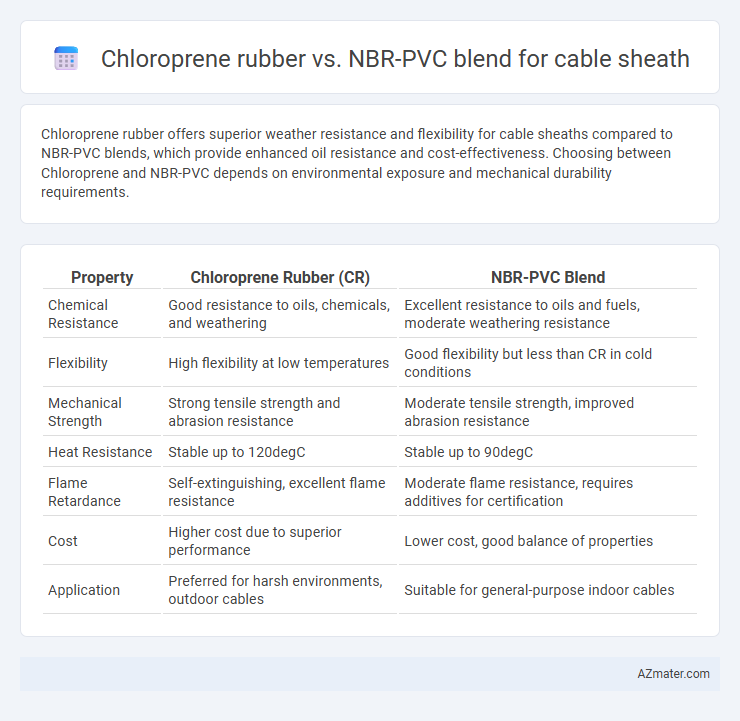Chloroprene rubber offers superior weather resistance and flexibility for cable sheaths compared to NBR-PVC blends, which provide enhanced oil resistance and cost-effectiveness. Choosing between Chloroprene and NBR-PVC depends on environmental exposure and mechanical durability requirements.
Table of Comparison
| Property | Chloroprene Rubber (CR) | NBR-PVC Blend |
|---|---|---|
| Chemical Resistance | Good resistance to oils, chemicals, and weathering | Excellent resistance to oils and fuels, moderate weathering resistance |
| Flexibility | High flexibility at low temperatures | Good flexibility but less than CR in cold conditions |
| Mechanical Strength | Strong tensile strength and abrasion resistance | Moderate tensile strength, improved abrasion resistance |
| Heat Resistance | Stable up to 120degC | Stable up to 90degC |
| Flame Retardance | Self-extinguishing, excellent flame resistance | Moderate flame resistance, requires additives for certification |
| Cost | Higher cost due to superior performance | Lower cost, good balance of properties |
| Application | Preferred for harsh environments, outdoor cables | Suitable for general-purpose indoor cables |
Introduction to Cable Sheath Materials
Chloroprene rubber (CR) and NBR-PVC blend are commonly used materials for cable sheaths due to their excellent mechanical and chemical resistance properties. Chloroprene rubber offers superior weather resistance, flame retardancy, and flexibility, making it ideal for demanding outdoor and industrial applications. The NBR-PVC blend combines the oil resistance of nitrile rubber with the durability and cost-effectiveness of PVC, providing a balanced solution for cables exposed to oils and moderate environmental conditions.
Overview of Chloroprene Rubber
Chloroprene rubber, also known as neoprene, is valued for its excellent resistance to weathering, ozone, and hydrocarbons, making it a durable option for cable sheaths in harsh environments. It offers good flexibility, abrasion resistance, and thermal stability, which are critical for maintaining cable integrity under mechanical stress and temperature variations. Compared to NBR-PVC blends, chloroprene rubber provides superior chemical resistance and enhanced elasticity, ensuring long-term performance and protection of electrical cables.
Composition and Properties of NBR-PVC Blends
NBR-PVC blends for cable sheaths combine nitrile butadiene rubber (NBR) with polyvinyl chloride (PVC) to achieve enhanced chemical resistance, flexibility, and flame retardancy compared to chloroprene rubber. Typically, NBR content ranges from 30% to 70%, providing excellent oil and fuel resistance, while PVC contributes rigidity, weatherability, and improved mechanical strength. These blends exhibit balanced thermal stability, abrasion resistance, and electrical insulation properties, making them suitable for industrial and automotive cable applications where durability and resistance to harsh environments are critical.
Mechanical Properties Comparison
Chloroprene rubber exhibits superior tensile strength and excellent abrasion resistance, making it highly durable for cable sheath applications. NBR-PVC blends offer enhanced flexibility and improved resistance to oils and chemicals, providing better elongation at break but slightly lower mechanical strength compared to Chloroprene. The choice between these materials depends on the specific operational environment, with Chloroprene preferred for rugged mechanical durability and NBR-PVC for chemical exposure and flexibility demands.
Chemical and Weather Resistance
Chloroprene rubber offers superior chemical resistance to oils, solvents, and acids, making it highly durable in harsh industrial environments. NBR-PVC blends provide excellent resistance to oils and fuels but generally have lower resistance to ozone, UV radiation, and weathering compared to chloroprene rubber. For cable sheath applications requiring long-term exposure to outdoor conditions and chemical agents, chloroprene rubber delivers enhanced weather resistance and sustained mechanical performance.
Flame Retardancy and Safety
Chloroprene rubber exhibits excellent flame retardancy due to its inherent chlorine content, which helps self-extinguish flames and provides superior resistance to combustion in cable sheath applications. NBR-PVC blends offer moderate flame retardancy, leveraging the PVC component's chlorine-based flame resistance, but typically require additional additives to meet stringent safety standards. For enhanced cable safety, chloroprene rubber is preferred in environments demanding high flame retardant performance and reliable toxic gas suppression.
Flexibility and Low-Temperature Performance
Chloroprene rubber offers superior flexibility and excellent low-temperature performance, maintaining elasticity and resilience down to -40degC, making it ideal for cable sheaths exposed to harsh climates. NBR-PVC blends demonstrate good chemical resistance and mechanical strength but generally exhibit reduced flexibility and become brittle at lower temperatures, typically below -20degC. For applications requiring sustained flexibility and durability in cold environments, chloroprene rubber is the preferred material choice.
Environmental and Aging Resistance
Chloroprene rubber offers superior resistance to ozone, weathering, and ultraviolet radiation, making it highly effective for cable sheaths exposed to harsh environmental conditions. NBR-PVC blends provide excellent oil and chemical resistance but tend to degrade faster under prolonged UV exposure and oxygen aging. The choice between these materials depends on balancing environmental durability with chemical resistance requirements in cable sheath applications.
Cost Effectiveness and Processability
Chloroprene rubber offers strong weather resistance and durability for cable sheaths but typically comes with higher raw material costs compared to NBR-PVC blends. NBR-PVC blends provide superior flexibility and excellent oil resistance, enhancing processability with lower extrusion temperatures and reduced cycle times, which lowers overall production expenses. The cost-effectiveness of NBR-PVC blends is attributed to their balanced performance and easier manufacturing, making them a preferred choice in applications where budget constraints and efficiency are critical.
Application Suitability and Recommendations
Chloroprene rubber offers excellent resistance to weathering, ozone, and chemicals, making it highly suitable for outdoor and industrial cable sheath applications requiring durability and flame resistance. NBR-PVC blends provide superior oil resistance and mechanical strength, ideal for cables used in environments exposed to oils, fuels, and mechanical stress such as automotive and industrial machinery. For outdoor installations demanding flexibility and weather protection, chloroprene rubber is recommended, whereas NBR-PVC blends are preferred for oil-rich or mechanically demanding settings.

Infographic: Chloroprene rubber vs NBR-PVC blend for Cable sheath
 azmater.com
azmater.com